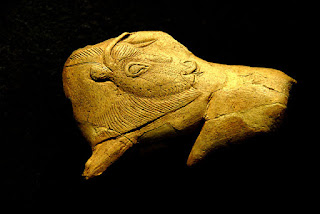She explained that you find a nice rock or cobble stone and paint it however you like, then you "hide" it for others to find. People put some sort of identifier on the rocks so the finder can post a message on line that a particular rock was found. The finder can keep the rock or re-hide it in the same spot or another location.
How could I possibly resist?
So I spent an enjoyable afternoon painting my rock and chatting with my friend and learned about painting rocks. It's easy but then not so easy.
First thing: You gotta pick a rock.
A rock is a rock is a rock. 1It sounds simple but you know when you are about to become a Leonardo, all of sudden the shape, size, texture and color of the rock becomes a Big Deal. My friend had a large selection of rocks to pick from that had already been washed and dried. I must of looked over a dozen before I selected "My Rock".
Next up: What are you going to paint.
What do you paint, when you paint on a wall? 2You can paint anything you like on the rock but some rocks "hint" at an idea, sort of like the adage that the sculptor's marble block tells them what's inside, rocks can hint at images that would fit their configuration. My friend had a lot of samples of rocks her family had painted. Sunshine rays, geometric decorations, complex geometries, free form drawings and cartoon images created from transfer paper.
Then the hardest part: What colors.
What are the colors you use when you paint? 2Like any work of art, the colors make a difference. My friend had about a hundred different colors and paint media to chose from. The basic paint is an acrylic poster type paint but there are painting marker-style pens for fine details and you can finish the job with an overlay of clear acrylic for a high-sheen look to your rock. She said they pick up a load of paints when the craft stores have sales and she had a dozen or more small brushes to select from.
Since the main object is for someone to find it, I selected some bright colors. It was surprising that some colors worked better than others and I had to re-do-over a few spots when my selected color turned out to be a dud on my particular rock.
The last item is: Paint the Rock.
I paint what I paint. 2
 |
| Magdalenian Horse c. 15,000 BCE 5 |
There are the major cave works like Lascaux and Pech Merle 4 in France where the wild life and spotted horses of prehistoric times are recorded. There are myriad images painted in caves, on cliffs and overhangs all over the world. There are carvings and etchings of great intricacies that are some humanity's earliest expressions of the universe.
There are portable artworks too, rocks etched and carved in great detail; their purpose is not known but they were carried far from the location of the rock's origin. Deer horns, bones, ivory and just about anything portable served the same purpose. 5
We've been creating and carting around a lot of stuff for a long time.
 |
| Bison Licking Insect Bite c. 15,000 BCE 5 |
 |
| Mani Stone6 |
Perhaps many many years from now, some future person will come across our current expressions of universal connection. They will ponder the meanings of the designs and images. They will analyze all the colors and paint types and consider individual brush strokes under powerful microscopes. They will consider the origin of the rocks and maybe extract DNA captured during painting. They will wonder at the variety and styles and no doubt completely lose their way in ascribing some massive, theoretical meaning to each rock.
Then again, maybe they will be correct, because there is some ancestral need to say "I was here". A need that transcends our current status, arising from our collective humanity. A need to match the universe against our most enduring weapon: our imagination.
I left my completed masterpiece in the care of my friend.
...after all,It is just a rock with some paint on it....
It's my wall . . . 2
But it's "My Rock".
 |
| Fire Pit painted rock KimB 02/2018 |
References
-
https://en.wikipedia.org/wiki/Gertrude_Stein
https://en.wikipedia.org/wiki/Rose_is_a_rose_is_a_rose_is_a_rose - I Paint What I See by E.B. White
First printed in The New Yorker of May 20, 1933.
https://en.wikipedia.org/wiki/E._B._White - https://en.wikipedia.org/wiki/Rock_art
https://en.wikipedia.org/wiki/Cave_painting
https://en.wikipedia.org/wiki/List_of_Stone_Age_art
- https://en.wikipedia.org/wiki/Lascaux
https://en.wikipedia.org/wiki/Pech_Merle - Magdalenian Horse, c. 15,000 BCE
Bison Licking Insect Bite c. 15,000 BCE - https://en.wikipedia.org/wiki/Mani_stone
1 comment:
Great tale .. we enjoyed it thoroughly !! this is the place where we say .. YOU ROCK !!! .. hehe
Well done .. makes us want to give it go .. after all ..we're the 'rock' generation ... lol
Thanks !
Post a Comment